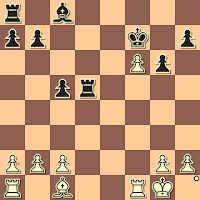Having a "feel" for the Jerome Gambit (1.e4 e5 2.Nf3 Nc6 3.Bc4 Bc5 4.Bxf7+) saves a lot of time, especially in positions that need close examination to understand - but, in games where there is no time for close examination.
In the following game, Black seems to have side-stepped a handful of dangers, only to fall into a tactical mess.
angelcamina - yisustorres19
1 0 bullet, lichess.org, 2019
1. e4 e5 2.Nf3 Nc6 3.Bc4 Nf6 4.Nc3 Bc5 5.Bxf7+
The Italian Four Knights Jerome Gambit.
5...Kxf7 6.Nxe5+ Nxe5 7.d4 Bxd4 8.Qxd4 Re8 9.O-O d6
Black is doing well. He can castle-by-hand and then make plans for the future. But - quickly. He has only one minute for the game.
10.f4 c5 11.Qe3 Nc4 12.Qd3 Nb6
13.e5 dxe5
Stockfish 10, which probably plays quite well at the 1 0 time control, suggests, instead, the tactical exhanges 13...Ng4 14.Nb5 dxe5 15.fxe5+ Kg8 16.Qxd8 Rxd8 17.Nc7 Bd7 18.e6 Rac8 19.Bg5 Nf6 20.Bxf6 gxf6 21.e7 Re8 22.Nxe8 Rxe8 23.Rxf6 Rxe7 when Black will have two pieces for a Rook and a pawn, and, perhaps, an edge in the game.
14.Qxd8 Rxd8 15.fxe5 Nbd5
16.Nxd5 Rxd5 17.exf6 g6
Black has given back his extra piece, and seems to be heading toward a drawn Bishops-of-opposite-colors endgame.
18.Be3 Bf5 19.c3 b6 20.Rae1 Re8 21.Bg5
So far, so good. White's f-pawn is adequately blockaded.
21...Bd3
What's not to like about this move? It attacks White's Rook at f1, while simultaneously attacking the unprotected Bishop at g5. However, it was not possible to examine closely and see that it blows up Black's game, not White's.
22.Rxe8
Ouch. The Black King is stuck at f7, blockading the pawn.
22...Bxf1
Best was giving up the exchange with 22...Rxg5 23.Re7+ Kf8 24.Rd1. Checkmate now follows.
23. Re7+ Kf8 24. Bh6+ Kg8 25. f7+ Kh8 26. Re8 checkmate
In a bullet (1 minute, no increment) game, almost anything can happen. The following game is a good example - White reaches a position where he has 3 more pawns, 1 more piece, but hardly any more time. He must surrender 1/2 a point.
angelcamina - yisustorres19
1 0 bullet, lichess.org, 2019
1.e4 e5 2.Nf3 Nc6 3.Bc4 Nf6 4.Nc3 Bc5 5.Bxf7+
The Italian Four Knights Jerome Gambit. If Black was hoping for a quiet game, this move probably comes as a disappointment.
5...Kxf7 6.Nxe5+ Nxe5 7.d4 Nc4
This is a creative response, and a rare one: there are only two other examples in The Database (White won both).
8.dxc5 Re8 9.f3 d6 10.cxd6 Nxd6
Black's plan with his Knight has worked, and he holds a piece for 2 pawns advantage.
11.O-O c6 12.Bg5
This thematic move allows Black to play 12...Qb6+, attacking White's b-pawn, but I can not make sense out of the computer's suggestion of the alternative, 12.a4.
12...h6 13.Bh4 g5 14.Bg3 Re6
Overlooking White's threat to the 2 Knights.
15.e5 Nf5
Hanging his Queen, which neither player notices.
16.exf6 Qxd1 17.Raxd1 Nxg3 18.hxg3 Rxf6
19.g4 Be6 20.Rd6 Ke7 21.Rfd1 Bd5 22.Nxd5+ Kxd6 23.Nxf6+ Ke6 24.Ne4 Re8
White has the game well under control.
25.Rd6+ Ke5 26.Rxh6 Kf4 27.Kf2 Rd8
This is a mistake, because?
Because now the subtle 28.Re6 would threaten g2-g3, checkmate.
White's choice is also winning, but it suggests that his clock is ticking down.
28.Rf6+ Ke5 29.Rf5+ Ke6 30.Rxg5 b5 31.Rg6+ Kd5 32.Rg5+ Ke6 33.Nc5+ Kd6
Black is running out of time, and so allows the crushing 34.Nb7+ Kd7 35.Nxd8.
But, White is running out of time, too.
34.Ne4+ Ke6 Drawn
The position can be repeated quickly, and both players sigh with relief.
I have looked at Black's defense in the following game before. It is another one of those lines that feels like it might work, because it is similar to a couple of lines that do - but is, in fact, a scary looking error. In a bullet game, it comes off more as a bluff that does not fool the opponent.
angelcamina - yisustorres19
1 0 bullet, lichess.org, 2019
1.e4 e5 2.Nf3 Nc6 3.Bc4 Bc5 4.Bxf7+
4...Kxf7 5.Nxe5+ Nxe5 6.Qh5+ g6 7.Qxe5 Bd6
Black could play the Blackburne Defense with 7...d6, or the Whistler Defense with 7...Qe7. In the first, White can take the Rook and avoid disaster if he knows the complicated followup. In the second, taking the Rook is immediately self-destructive.
So - why not 7...Bd6?
8.Qxh8 Qf6
Okay, this is an indication that Black is constructing his defense move-by-move. It was time, instead - especially since the time control was one minute, no increment - to go all-out for something scary like 8...Qh4 9.d3 Nf6, temporarily trapping White's Queen as in the Blackburne Defense. Then, after 10.Nd2 Ng4 11.Nf3 Qxf2+ 12.Kd1 White's King looks at risk. The question is, how does Black continue? The greedy 12...Qxg2 allows White to checkmate, starting with 13.Ng5+. Best for Black seems to be 12...Bf8, unblocking the d-pawn, and after 13.h3 Qxg2 14.Qxh7+ Bg7 15.Ng5+ Kf6 16.hxg4 d6 17.Qh2 Bxg4+ 18.Ke1 the attack on White's King has run down, and Black's bluff has been called.
9.Qxh6+ Qg7 10.Qxg7+ Kxg7 11.0-0
White is ahead the exchange and 3 pawns. He just has to play ordinary chess now, nothing fancy.
11...Be5 12.f4 Bd4+ 13.Kh1 Nf6 14.c3 Bb6
15.e5 Ng4 16.h3 Nf2+ 17.Kh2 Nd3
Blocking White's development - but he soon gives the idea up.
18.Na3 Nxc1 19.Raxc1 d6 20.d4 dxe5 21.fxe5 c6 22.Nc4 Bc7 23.Nd6 Bf5
24.Nxf5+ gxf5 25.Rxf5 Rf8 26.Rxf8 Kxf8 27.Rf1+ Ke7
The game has simplified, and only the clock can hurt White. He creates a couple of Queens and finishes things.
28.g4 c5 29.g5 cxd4 30.cxd4 Bb6 31.Rf4 Ke6 32.g6 Kd5 33.g7 Bxd4 34.g8=Q+ Kxe5 35.Rxd4 Kxd4 36.h4 Kc5 37.h5 Kb4 38.h6 b5 39.h7 Ka5 40.h8=Q a6 41.Qc3+ b4 42.Qd8+ Kb5 43.Qdc7 Ka4 44.Q7c6+ Ka5 45.Q3c5 checkmate























